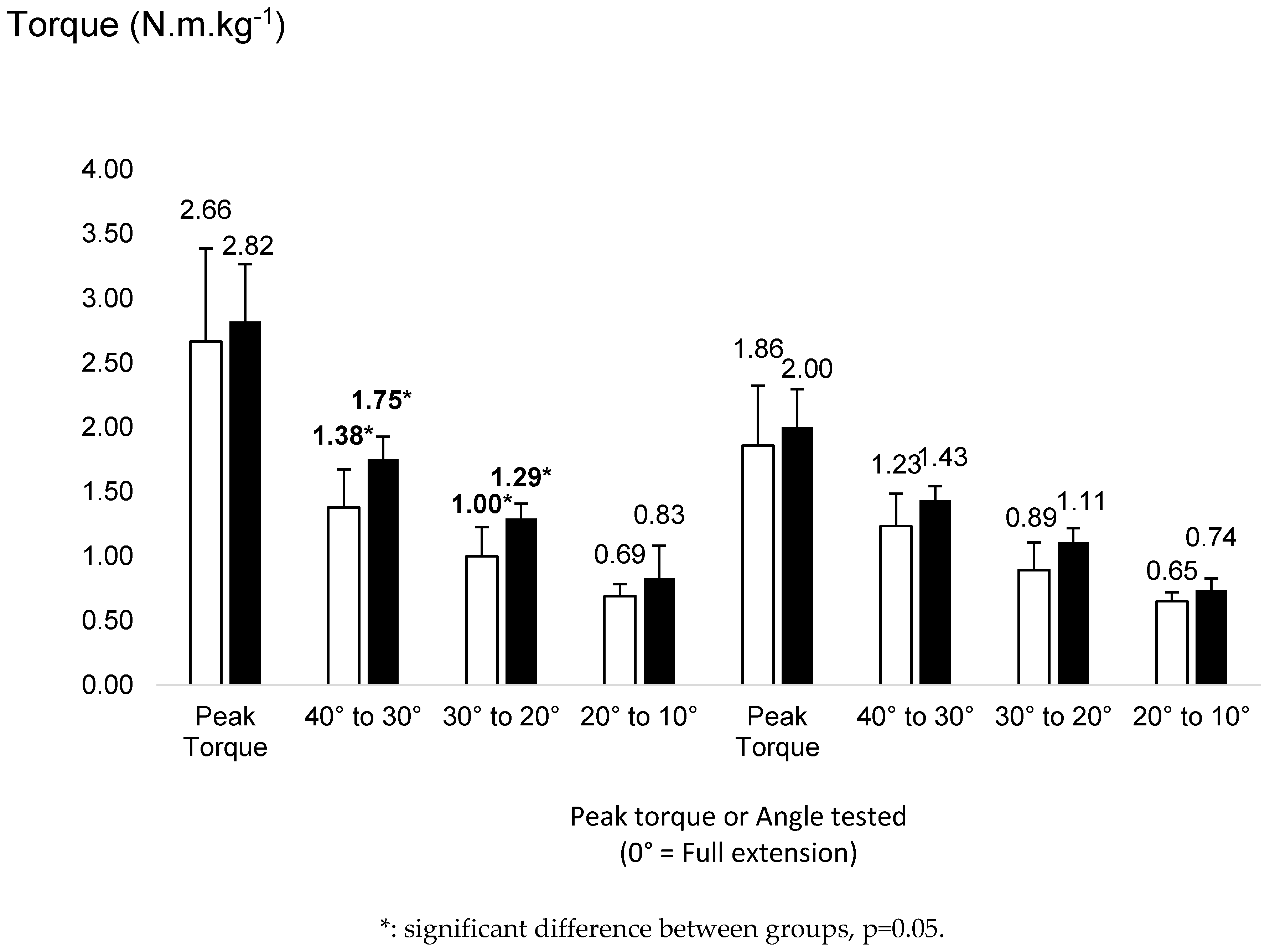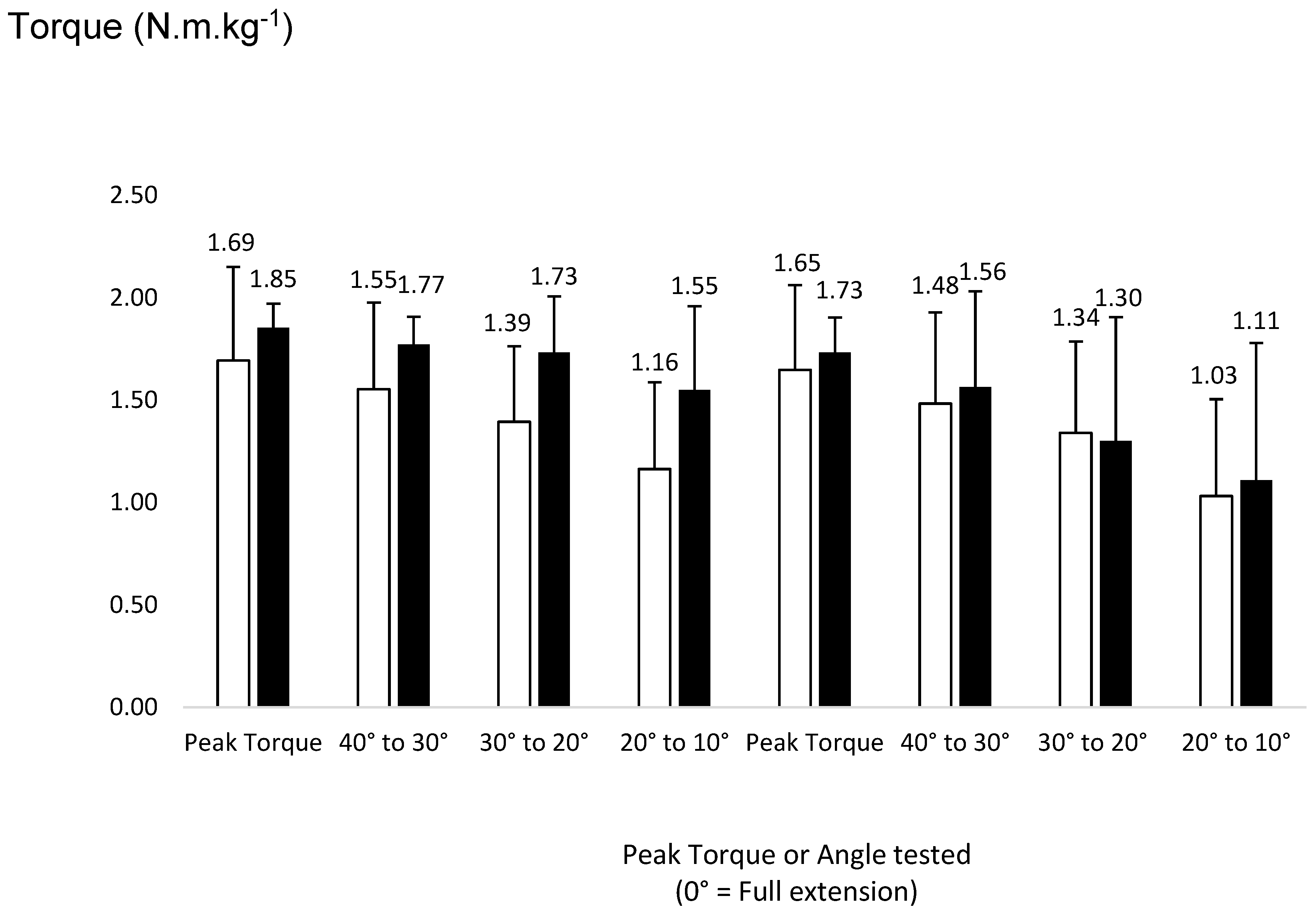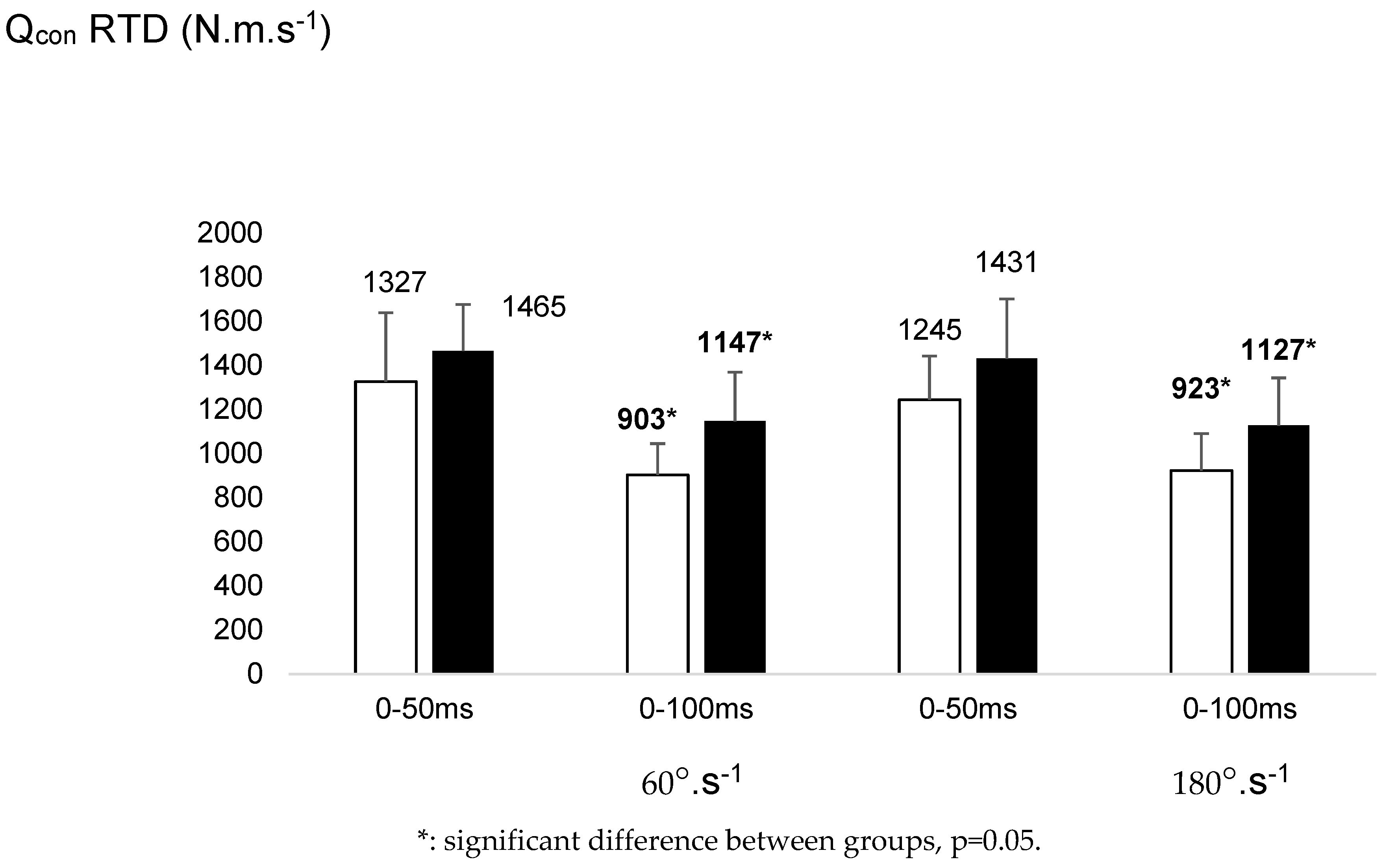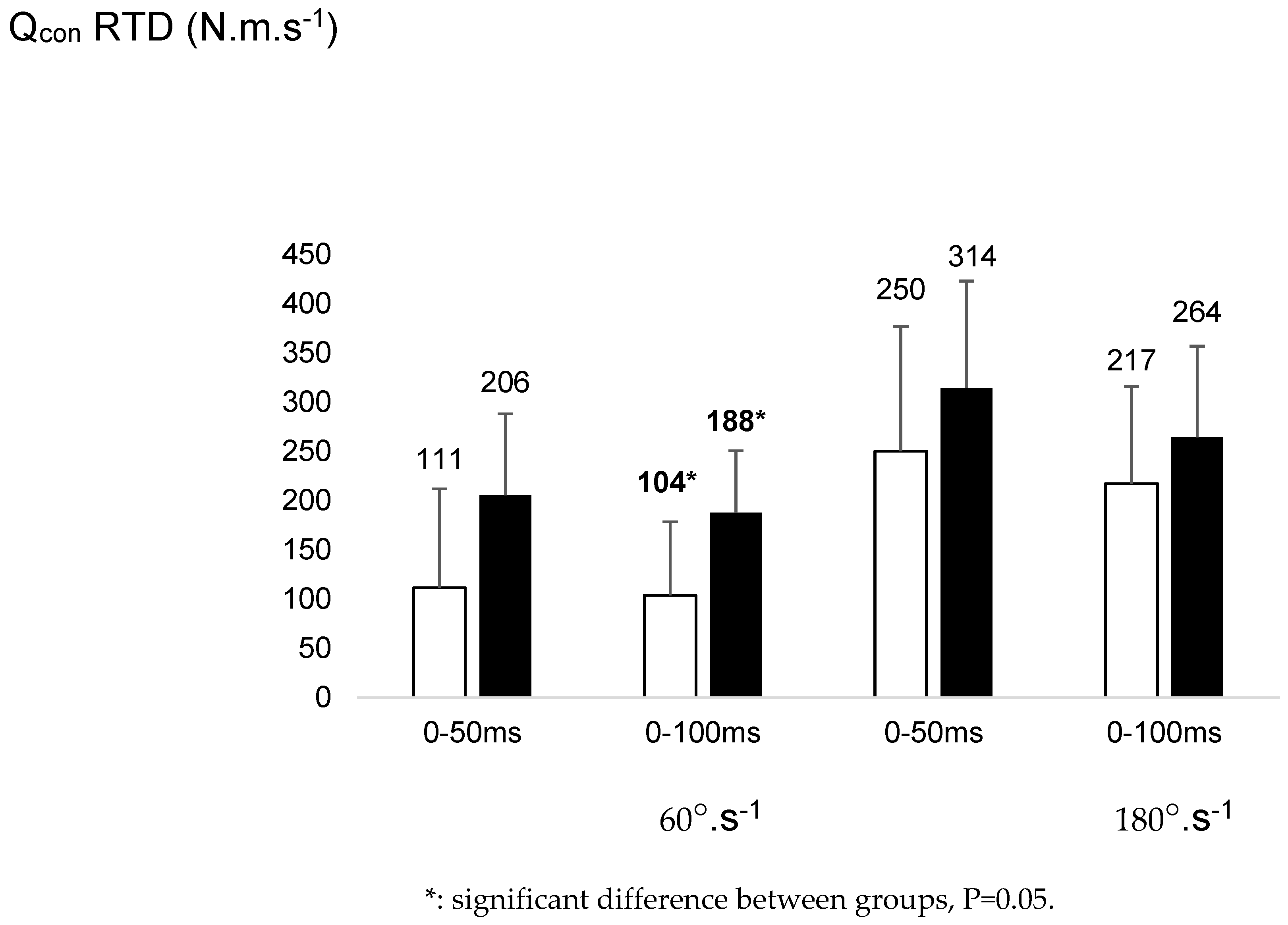Submitted:
30 August 2023
Posted:
30 August 2023
You are already at the latest version
Abstract
Keywords:
Introduction
Materials and Methods
Participants
Procedures
- Limb symmetry index (LSI) for all parameters: = ([(operated-non-operated)/non-operated] x 100.
Statistical Analyses
Results
Discussion
Author Contributions
Funding Information
Ethics Statements
Conflicts of Interest
References
- Ardern, C.L.; Webster, K.E.; Taylor, N.F.; Feller, J.A. Return to sport following anterior cruciate ligament reconstruction surgery: a systematic review and meta-analysis of the state of play. British journal of sports medicine 2011, 45, 596–606. [Google Scholar] [CrossRef] [PubMed]
- DeFazio, M.W.; Curry, E.J.; Gustin, M.J.; Sing, D.C.; Abdul-Rassoul, H.; Ma, R.; Fu, F.; Li, X. Return to sport after ACL reconstruction with a BTB versus hamstring tendon autograft: a systematic review and meta-analysis. Orthopaedic journal of sports medicine 2020, 8, 2325967120964919. [Google Scholar] [CrossRef] [PubMed]
- Ardern, C.L.; Glasgow, P.; Schneiders, A.; Witvrouw, E.; Clarsen, B.; Cools, A.; Gojanovic, B.; Griffin, S.; Khan, K.M.; Moksnes, H.; Mutch, S.A. 2016 Consensus statement on return to sport from the First World Congress in Sports Physical Therapy. Bern. British journal of sports medicine 2016, 50, 853–864. [Google Scholar] [CrossRef]
- Nwachukwu, B.U.; Adjei, J.; Rauck, R.C.; Chahla, J.; Okoroha, K.R.; Verma, N.N.; Allen, A.A.; Williams, RJ., III. ‘How much do psychological factors affect lack of return to play after anterior cruciate ligament reconstruction? A systematic review. Orthopaedic journal of sports medicine 2019, 7, 2325967119845313. [Google Scholar] [CrossRef]
- Ardern, C.L.; Österberg, A.; Tagesson, S.; Gauffin, H.; Webster, K.E.; Kvist, J. The impact of psychological readiness to return to sport and recreational activities after anterior cruciate ligament reconstruction. British journal of sports medicine 2014, 48, 1613–1619. [Google Scholar] [CrossRef] [PubMed]
- Kvist, J.; Ek, A.; Sporrstedt, K.; Good, L. Fear of re-injury: a hindrance for returning to sports after anterior cruciate ligament reconstruction. Knee surgery, sports traumatology, arthroscopy 2005, 13, 393–397. [Google Scholar] [CrossRef]
- Lentz, T.A.; Zeppieri Jr, G.; Tillman, S.M.; Indelicato, P.A.; Moser, M.W.; George, S.Z.; Chmielewski, T.L. Return to preinjury sports participation following anterior cruciate ligament reconstruction: contributions of demographic. knee impairment, and self-report measures. journal of orthopaedic & sports physical therapy 2012, 42, 893–901. [Google Scholar] [CrossRef]
- McCullough, K.A.; Phelps, K.D.; Spindler, K.P.; Matava, M.J.; Dunn, W.R.; Parker, R.D.; Moon Group Reinke, E.K. Return to high school–and college-level football after anterior cruciate ligament reconstruction: a Multicenter Orthopaedic Outcomes Network (MOON) cohort study. The American journal of sports medicine 2012, 40, 2523–2529. [Google Scholar] [CrossRef]
- Csapo, R.; Hoser, C.; Gföller, P.; Raschner, C.; Fink, C. Fitness, knee function and competition performance in professional alpine skiers after ACL injury. Journal of science and medicine in sport 2019, 22, S39–S43. [Google Scholar] [CrossRef]
- Fischer, F.; Fink, C.; Herbst, E.; Hoser, C.; Hepperger, C.; Blank, C.; Gföller, P. Higher hamstring-to-quadriceps isokinetic strength ratio during the first post-operative months in patients with quadriceps tendon compared to hamstring tendon graft following ACL reconstruction. Knee Surgery, Sports Traumatology, Arthroscopy 2018, 26, 418–425. [Google Scholar] [CrossRef]
- Guney-Deniz, H.; Harput, G.; Kaya, D.; Nyland, J.; Doral, M.N. Quadriceps tendon autograft ACL reconstructed subjects overshoot target knee extension angle during active proprioception testing. Knee Surgery, Sports Traumatology, Arthroscopy 2020, 28, 645–652. [Google Scholar] [CrossRef]
- Lee, J.K.; Lee, S.; Lee, M.C. Outcomes of anatomic anterior cruciate ligament reconstruction: bone–quadriceps tendon graft versus double-bundle hamstring tendon graft. The American journal of sports medicine 2016, 44, 2323–2329. [Google Scholar] [CrossRef] [PubMed]
- Myer, G.D.; Ford, K.R.; Foss, K.D.B.; Liu, C.; Nick, T.G.; Hewett, T.E. The relationship of hamstrings and quadriceps strength to anterior cruciate ligament injury in female athletes. Clinical journal of sport medicine 2009, 19, 3–8. [Google Scholar] [CrossRef] [PubMed]
- Wild, C.Y.; Steele, J.R.; Munro, B.J. Insufficient hamstring strength compromises landing technique in adolescent girls. Medicine & Science in Sports & Exercise 2013, 45, 497–505. [Google Scholar]
- Ward, S.H.; Blackburn, J.T.; Padua, D.A.; Stanley, L.E.; Harkey, M.S.; Luc-Harkey, B.A.; Pietrosimone, B. Quadriceps neuromuscular function and jump-landing sagittal-plane knee biomechanics after anterior cruciate ligament reconstruction. Journal of athletic training 2018, 53, 135–143. [Google Scholar] [CrossRef]
- Grindem, H.; Snyder-Mackler, L.; Moksnes, H.; Engebretsen, L.; Risberg, M.A. Simple decision rules can reduce reinjury risk by 84% after ACL reconstruction: the Delaware-Oslo ACL cohort study. British journal of sports medicine 2016, 50, 804–808. [Google Scholar] [CrossRef]
- Beynnon, B.D.; Fleming, B.C.; Johnson, R.J.; Nichols, C.E.; Renström, P.A.; Pope, M.H. Anterior cruciate ligament strain behavior during rehabilitation exercises in vivo. The American journal of sports medicine 1995, 23, 24–34. [Google Scholar] [CrossRef]
- Yu, B.; Garrett, W.E. Mechanisms of non-contact ACL injuries. British journal of sports medicine 2007, 41, 47–51. [Google Scholar] [CrossRef]
- Cohen, D.D.; Zhao, B.; Okwera, B.; Matthews, M.J.; Delextrat, A. ‘Angle-specific eccentric hamstring fatigue after simulated soccer. International Journal of Sports Physiology and Performance 2015, 10, 325–331. [Google Scholar] [CrossRef]
- Hammond, J.A. Strength profiling using isokinetic dynamometry following anterior cruciate ligament reconstruction: Implications for rehabilitation and return to sport decision making. PhD thesis, University of Gloucestershire, 2022, 10 November 2022. [Google Scholar]
- Zebis, M.K.; Aagaard, P.; Andersen, L.L.; Hölmich, P.; Clausen, M.B.; Brandt, M.; Husted, R.S.; Lauridsen, H.B.; Curtis, D.J.; Bencke, J. First-time anterior cruciate ligament injury in adolescent female elite athletes: A prospective cohort study to identify modifiable risk factors. Knee Surgery and Sports Traumatology and Arthroscopy 2021, 30, 1341–1351. [Google Scholar] [CrossRef]
- Bates, N.A.; Schilaty, N.D.; Ueno, R.; Hewett, T.E. Timing of strain response of the ACL and MCL relative to impulse delivery during simulated landings leading up to ACL failure. Journal of applied biomechanics 2020, 36, 148–155. [Google Scholar] [CrossRef]
- Burgi, C.R.; Peters, S.; Ardern, C.L.; Magill, J.R.; Gomez, C.D.; Sylvain, J.; Reiman, M.P. Which criteria are used to clear patients to return to sport after primary ACL reconstruction? A scoping review. British journal of sports medicine 2019, 53, 1154–1161. [Google Scholar] [CrossRef] [PubMed]
- Kadija, M.; Knežević, O; Milovanović, D; Nedeljković, A; Mirkov, D.M. The effect of anterior cruciate ligament reconstruction on hamstring and quadriceps muscle function outcome ratios in male athletes. Srpski arhiv za celokupno lekarstvo 2016, 144, 151–157. [Google Scholar] [CrossRef]
- Mirkov, D.M.; Knezevic, O.M.; Maffiuletti, N.A.; Kadija, M.; Nedeljkovic, A.; Jaric, S. Contralateral limb deficit after ACL-reconstruction: an analysis of early and late phase of rate of force development. Journal of sports sciences 2017, 35, 435–440. [Google Scholar] [CrossRef] [PubMed]
- O’Connor, R.F.; King, E.; Richter, C.; Webster, K.E.; Falvey, É.C. No relationship between strength and power scores and anterior cruciate ligament return to sport after injury scale 9 months after anterior cruciate ligament reconstruction. The American journal of sports medicine 2020, 48, 78–84. [Google Scholar] [CrossRef] [PubMed]
- Carolan, D.; King, E.; Richter, C.; Franklyn-Miller, A.; Moran, R.; Jackson, M. Differences in strength, patient-reported outcomes, and return-to-play rates between athletes with primary versus revision ACL reconstruction at 9 months after surgery. Orthopaedic Journal of Sports Medicine 2020, 8, 2325967120950037. [Google Scholar] [CrossRef] [PubMed]
- Webster, K.E.; Feller, J.A. Development and validation of a short version of the anterior cruciate ligament return to sport after injury (ACL-RSI) scale. Orthopaedic journal of sports medicine 2018, 6, 2325967118763763. [Google Scholar] [CrossRef]
- Webster, K.E.; Feller, *!!! REPLACE !!!*; J.A., *!!! REPLACE !!!*. Who passes return-to-sport tests, and which tests are most strongly associated with return to play after anterior cruciate ligament reconstruction? Orthopaedic journal of sports medicine 2020, 8, 2325967120969425. [Google Scholar] [CrossRef]
- Drouin, J.M.; Valovich-mcLeod, T.C.; Shultz, S.J.; Gansneder, B.M.; Perrin, D.H. Reliability and validity of the Biodex system 3 pro isokinetic dynamometer velocity, torque and position measurements. European journal of applied physiology 2004, 91, 22–29. [Google Scholar]
- De Ste Croix, M.; Priestley, A.; Lloyd, R.; Oliver, J. () ‘Age-Related Differences in Functional Hamstring/Quadriceps Ratio Following Soccer Exercise in Female Youth Players: An Injury Risk Factor. ’ Pediatrics and Exercise Science 2018, 30, 376–382. [Google Scholar] [CrossRef]
- Zhang, Q.; Morel, B.; Trama, R.; Hautier, C. Influence of Fatigue on the Rapid Hamstring/Quadriceps Force Capacity in Soccer Players. Frontiers in Physiology 2021, 12, 627674. [Google Scholar] [CrossRef] [PubMed]
- Krosshaug, T.; Nakamae, A.; Boden, B.P.; Engebretsen, L.; Smith, G.; Slauterbeck, J.R.; Hewett, T.E.; Bahr, R. Mechanisms of anterior cruciate ligament injury in basketball: Video analysis of 39 cases. American Journal of Sports Medicine 35, 359–367. [CrossRef] [PubMed]
- Mentiplay, B.F.; Perraton, L.G.; Bower, K.J.; Adair, B.; Pua, Y.H.; Williams, G.P.; McGaw, R.; Clark, R.A. Assessment of Lower Limb Muscle Strength and Power Using Hand-Held and Fixed Dynamometry: A Reliability and Validity Study. PLoS One 2015, 10, e0140822. [Google Scholar] [CrossRef]
- Cohen, J. () Statistical Power Analysis for the behavioural sciences. 1988, 19–66. [Google Scholar]
- Turpeinen, J.T.; Freitas, T.T.; Rubio-Arias, J.Á.; Jordan, M.J.; Aagaard, P. Contractile rate of force development after anterior cruciate ligament reconstruction—a comprehensive review and meta-analysis. Scandinavian Journal of Medicine & Science in Sports 2020, 30, 1572–1585. [Google Scholar]
- Maffiuletti, N.A.; Aagaard, P.; Blazevich, A.J.; Folland, J.; Tillin, N.; Duchateau, J. Rate of force development: physiological and methodological considerations. European journal of applied physiology 2016, 116, 1091–1116. [Google Scholar] [CrossRef]
- Buckthorpe, M. Optimising the late-stage rehabilitation and return-to-sport training and testing process after ACL reconstruction. Sports Medicine 2019, 49, 1043–1058. [Google Scholar] [CrossRef]
- Vila-Chã, C.; Falla, D.; Farina, D. Motor unit behaviour during submaximal contractions following six weeks of either endurance or strength training. Journal of Applied Physiology 2010, 109, 1455–1466. [Google Scholar] [CrossRef]
- Sancese, A.; Taylor, L.; Walsh, G.; Byrd, E.; Delextrat, A. ‘Effects of sprint versus strength training on risk factors for hamstring injury in football players. Journal of Sports Medicine and Physical Fitness 2023, 63, 580–587. [Google Scholar] [CrossRef]
- Birchmeier, T.; Lisee, C.; Kane, K.; Brazier, B.; Triplett, A.; Kuenze, C. Quadriceps muscle size following ACL injury and reconstruction: a systematic review. Journal of Orthopaedic Research 2020, 38, 598–608. [Google Scholar] [CrossRef]
- Buckthorpe, M.; Danelon, F.; La Rosa, G.; Nanni, G.; Stride, M.; Della Villa, F. Recommendations for hamstring function recovery after ACL reconstruction. Sports Medicine 2021, 51, 607–624. [Google Scholar] [CrossRef] [PubMed]
- Cavanaugh, J.T.; Powers, M. ACL rehabilitation progression: where are we now? Current reviews in musculoskeletal medicine 2017, 10, 289–296. [Google Scholar] [CrossRef] [PubMed]
- Bourne, M.N.; Opar, D.A.; Williams, M.D.; Shield, A.J. Eccentric Knee Flexor Strength and Risk of Hamstring Injuries in Rugby Union: A Prospective Study. American Journal of Sports Medicine 2015, 43, 663–2670. [Google Scholar] [CrossRef] [PubMed]
- Collings, T.J.; Diamond, L.E.; Barrett, R.S.; Timmins, R.G.; Hickey, J.T.; DUMoulin, W.S.; Williams, M.D.; Beerworth, K.A.; Bourne, M.N. Strength and Biomechanical Risk Factors for Noncontact ACL Injury in Elite Female Footballers: A Prospective Study. Medicine and Science in Sports and Exercise 2022, 54, 1242–1251. [Google Scholar] [CrossRef]




|
All Participants (n=12) |
Cases ACL-RSI Scores <81.4% (n=7) |
Controls ACL-RSI Scores >81.4% (n=5) |
|
|---|---|---|---|
| Age | 20.7 ± 2.5 | 20 ± 2.2 | 21.6 |
| Sex, male: female | 6:6 | 3:4 | 3:2 |
| Operated Side, right: left | 7:5 | 4:3 | 3:2 |
| Height (cm) | 174 ±8 | 170 ±5 | 179 ± 8 |
| Weight (Kg) | 70.2 ±8.5 | 68.7 ±7.5 | 72.26 ±10.3 |
| Body fat % | 18.2 ±8.3 | 20.9±9.9 | 14.32 ± 3.5 |
| Time Since Injury (months) | 38 ±21 | 33 ±18 | 46 ± 24 |
| Time Since Surgery (months) | 31 ±19 | 24 ±13 | 41 ±23 |
| Time Since RTS (months) Reported to have returned to PILOS, yes:no |
15 ±15 5:8 |
11 ±9 1:6 |
21 ±21 4:1 |
| Combined Injury, none: meniscal tear: Triad | 3:6:3 | 3:3:1 | 0:3:2 |
| Graft Type, HTG: PTG | 12:0 | 7:0 | 5:0 |
Disclaimer/Publisher’s Note: The statements, opinions and data contained in all publications are solely those of the individual author(s) and contributor(s) and not of MDPI and/or the editor(s). MDPI and/or the editor(s) disclaim responsibility for any injury to people or property resulting from any ideas, methods, instructions or products referred to in the content. |
© 2023 by the authors. Licensee MDPI, Basel, Switzerland. This article is an open access article distributed under the terms and conditions of the Creative Commons Attribution (CC BY) license (https://creativecommons.org/licenses/by/4.0/).





